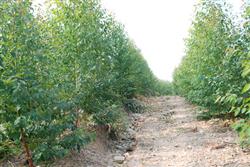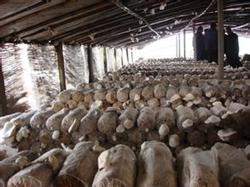The proportion of raw materials for cultivation of Pleurotus ostreatus should be reasonable.

Bailing mushroom is a new mushroom developed in recent years, because the development history is relatively short, so there are still many problems in cultivation techniques, especially the total output has not been raised, and the biological conversion rate of some mushroom farmers is less than 20%. Even in the case of high price, the economic benefit is also very general. According to the practice of cultivating a large number of Pleurotus ostreatus in recent years, the author makes the following analysis on the nutritional composition of Pleurotus ostreatus for reference. The reasonable proportion of nutrition plays an important role in the yield of Pleurotus ostreatus. Shouguang Edible Fungi Research Institute used 200000 bags of materials in 2002 and 2003, the main material used cottonseed shell, and adopted the formula of adding 20% wheat bran and 8% corn flour, the bioconversion rate was more than 60%. In 2005, pure cottonseed shell was used to grow Pleurotus ostreatus, 150000 bags were used, and the bioconversion rate was only 2030%. Therefore, the author introduces the problem in detail: the added nutrients should be dominated by organic nutrition and supplemented by inorganic nutrition, which is very helpful to enhance the stamina of Pleurotus ostreatus. Generally speaking, the organic nutrients are mainly composed of wheat bran, corn flour, rice bran, etc., and the general addition amount is 20-30%. The organic nutrition content is too large. One of the disadvantages is that the pollution rate is greatly increased, and the second is that it affects the air permeability of the culture materials. resulting in slow mycelium growth and delay the mushroom season. Inorganic nutrition is generally potassium dihydrogen phosphate, magnesium sulfate, etc., generally added 0.2% 0.5%, too much will affect the water absorption capacity of mycelium. It should be emphasized here that with the increase of the total yield of Pleurotus ostreatus, improving the nutritional content of the culture material is a very important aspect, and another aspect is to ensure that the culture material has a strong water absorption capacity. At present, the conventional cottonseed hull is generally short, but it is impossible to add a lot of water to the cottonseed shell with short cottonseed hull. If you use this raw material to cultivate Pleurotus ostreatus, during the period of mushroom emergence, the fruiting body will not get sufficient water supply. In this way, the commodity and growth specifications of the entity will be difficult to guarantee, let alone maintain a high yield. In this case, we can adjust the formula appropriately and add 30% to 50% of the raw materials with strong water absorption capacity, such as cotton soil wool, corncob, etc., which not only improves the water absorption of the culture material, but also saves the cost, which can be said to kill two birds with one stone. For the cultivation of Pleurotus ostreatus, the suitable water content of raw materials should be 60% 65%. Specifically, the ratio of material to water can be controlled at 1.15% 1.5% 1.6 before fermentation and about 1.3% before inoculation. Cotton velvet, as the garbage of the original cotton mill and cotton oil factory, has been well applied in recent years. The experimental base of Shouguang Edible Fungi Research Institute used the main material formula of half cotton skin and half soil wool to produce Pleurotus ostreatus in 2005, and achieved very good results. the highest bioconversion rate reached more than 80%, creating good economic benefits. Practice has proved that adding a certain amount of lime to the formula can promote the rapid growth of mycelium, and the amount of lime can be controlled at 2: 5%, so that the pH can be maintained at about 8: 9 after the completion of culture material fermentation. It is OK not to add lime, but the growth of mycelium will become slow, which will have a great impact on the reasonable arrangement of mushroom season. In short, the reasonable formulation of culture materials is a very flexible problem, we should according to local resources, scientific adjustment, as far as possible to increase the yield and commerciality of Pleurotus ostreatus to our satisfactory level.
- Prev

Master the suitable growing area of Eucalyptus and strictly control the quality of seedlings
Eucalyptus is one of the three fast-growing tree species with developed root system, strong absorption and large growth. There is an adequate supply of water and fertilizer, with a height of 1.5m per year and 5.5 meters high, and it can be cut and used in 4-5 years. The main nutrient elements absorbed by eucalyptus are nitrogen, phosphorus, potassium, calcium, magnesium, zinc, boron and so on. According to research, each eucalyptus tree is flat every year.
- Next

Method for fermenting culture material of Pleurotus nebrodensis
Pleurotus nebrodensis is a rare mushroom species developed in recent years. Its cultivation technology is becoming more and more mature, and the commodity of its products is getting higher and higher. I believe that in the near future, Pleurotus nebrodensis will become an ordinary member of the edible mushroom family like Flammulina velutipes and Coprinus comatus, and will be widely cultivated by mushroom farmers. From the looks of it, white spirit...
Related
- Fuxing push coffee new agricultural production and marketing class: lack of small-scale processing plants
- Jujube rice field leisure farm deep ploughing Yilan for five years to create a space for organic food and play
- Nongyu Farm-A trial of organic papaya for brave women with advanced technology
- Four points for attention in the prevention and control of diseases and insect pests of edible fungi
- How to add nutrient solution to Edible Fungi
- Is there any good way to control edible fungus mites?
- Open Inoculation Technology of Edible Fungi
- Is there any clever way to use fertilizer for edible fungus in winter?
- What agents are used to kill the pathogens of edible fungi in the mushroom shed?
- Rapid drying of Edible Fungi

